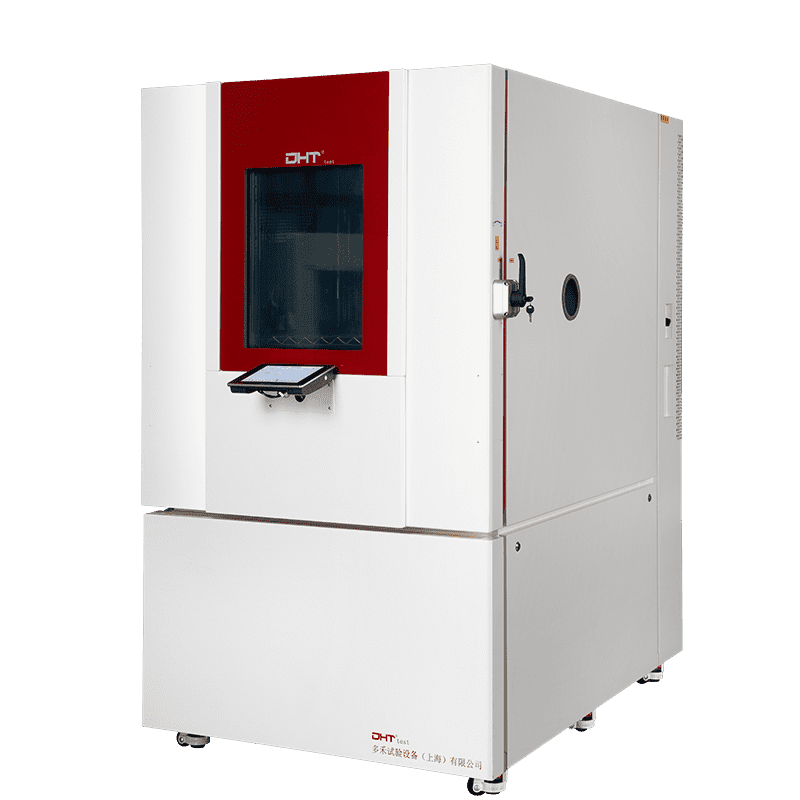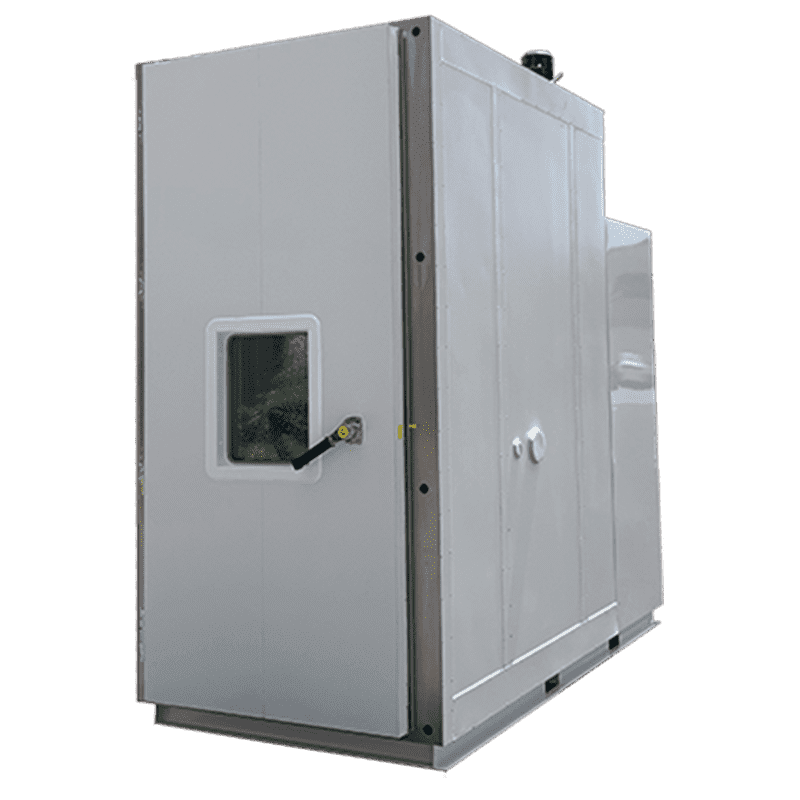Les caractéristiques typiques des chambres d'entrée incluent : un intérieur spacieux : accueille des véhicules entiers, des véhicules de transport ferroviaire, des sous-systèmes aérospatiaux, etc., permettant une entrée directe sans démontage.
-
Personnalisation technique : conception modulaire adaptée à la taille du produit, aux conditions de test et aux exigences d'accès. En résumé, les chambres d'essai d'entrée sont des plateformes complètes soutenant la validation environnementale au niveau du système, et non simplement des équipements à fonction unique.
-
Pourquoi les chambres d'essai d'entrée sont-elles essentielles pour les tests au niveau complet du véhicule ? Reproduction authentique des conditions du véhicule, éliminant les erreurs de démontage
-
Au stade des tests au niveau complet du véhicule - surtout lors de la validation des packs de batteries, des moteurs et des systèmes de contrôle électronique - les tests traditionnels nécessitent souvent un démontage fréquent, ce qui peut compromettre la fidélité des conditions et introduire des erreurs humaines. Les chambres d'entrée permettent de tester les véhicules dans leur ensemble, sans démontage, améliorant considérablement l'authenticité et la cohérence des données. Stress environnemental multi-couplé, améliorant la couverture des tests
-
Les chambres d'entrée peuvent appliquer simultanément des stress de température, d'humidité, de choc thermique, de vibration, de radiation et d'altitude, en conformité avec des normes strictes telles que GB/T 28046 et ISO 16750 pour les simulations au niveau du véhicule. Cela permet une évaluation efficace de la gestion thermique des batteries, des structures d'étanchéité et de la fiabilité des connexions électroniques. Réduction des cycles de test, amélioration de l'efficacité
Domaines d'application typiques des chambres d'essai d'entrée
Véhicules à énergies nouvelles et systèmes de batteries Tests d'endurance de température et de résistance aux intempéries de véhicules entiers Validation des fuites thermiques et des systèmes de refroidissement des packs de batteries
Équipements aérospatiaux et militaires
Évaluation de la durabilité environnementale des soutes, des compartiments de missiles et des cabines de véhicules Validation Évaluation des stress au niveau du système sous des environnements composés à haute altitude et haute radiation
Résistance des véhicules au sable soufflé par le vent, à une humidité et une chaleur élevées, et performances de démarrage à froid
-
Analyse de la réponse et de la stabilité mécanique à basse température du système de freinage
-
Véhicules spéciaux et équipements commerciaux
-
Tests de pénétration d'eau de la transmission, d'anti-givrage et de résistance à la chaleur
-
Validation des performances d'interférence et d'étanchéité des systèmes de communication et de contrôle électronique
-
-
Ces applications pratiques démontrent que les chambres d'entrée sont devenues incontournables dans le domaine de l'ingénierie de fiabilité à travers les industries, surtout lors du développement et de la validation de systèmes complexes et de grande valeur.
-
Quatre facteurs clés à considérer lors de la sélection des chambres d'essai d'entrée
-
Taille et exigences d'accès
-
L'objet du test est-il un véhicule complet ? L'intégration d'un chariot ferroviaire ou d'une plateforme élévatrice est-elle nécessaire ? L'ouverture de la chambre permet-elle l'entrée du véhicule ? Ces aspects influencent directement la conception structurelle et la configuration.
-
-
Contraintes et exigences fonctionnelles prévues
-
Des tests de choc thermique, de cycle d'humidité ou de poussière sont-ils nécessaires ? Les taux de variation de température et la précision du contrôle de l'humidité sont-ils suffisants pour respecter les normes ? Ces besoins fonctionnels déterminent la sélection des systèmes de base.
-
Efficacité et fiabilité du système
-
-
La chambre supporte-t-elle le contrôle de la fréquence variable, les modes d'économie d'énergie et l'auto-diagnostic ? Peut-elle supporter une longue opération continue ? La stabilité impacte le contrôle des tests et la consommation d'énergie.
-
Personnalisation par le fabricant et capacité de service
-
Les chambres d'entrée sont des équipements hautement techniques et personnalisables. L'expertise du fabricant dans la conception structurelle, l'expérience d'installation et la réactivité après-vente influencent directement le succès du projet et la maintenabilité.
-
Les tests environnementaux modernes ont évolué au-delà des seuls paramètres de température ou d'humidité vers la numérisation, l'intégration de plateformes et l'intelligence - les chambres d'entrée ne font pas exception, avançant rapidement dans des domaines tels que :
-
Plateformes intégrées de simulation multi-stress : combinant des stress environnementaux divers pour soutenir les besoins de test complexes. Conception structurelle modulaire : facilitant les mises à jour futures et prolongeant la durée de vie de l'équipement.
-
Acquisition de données intelligentes et surveillance à distance : l'informatique en périphérie et l'IoT industriel améliorent la visibilité des tests et l'utilisation des données. Environnement Conceptions économes en énergie et vertes : en optimisant la consommation d'énergie pour répondre aux objectifs de neutralité carbone. DHT® développe activement une nouvelle génération de chambres d'entrée hautement intelligentes, fiables et adaptables pour aider les clients à construire des capacités de validation environnementale au niveau du véhicule leaders de l'industrie.
-
Conclusion : Les chambres d'essai d'entrée - La pierre angulaire stratégique des tests de haute fiabilité Alors que les produits de haute technologie tendent vers une plus grande échelle, une intégration des systèmes et des conditions environnementales extrêmes
-
ont évolué d'appareils de test à usage unique vers des parts indispensables des stratégies de fiabilité produit des entreprises. Ils améliorent non seulement la précision scientifique et la précision dans la validation des produits, mais fournissent également un support de test essentiel pour gagner sur les marchés compétitifs. Si votre équipe envisage de construire des capacités de test au niveau du véhicule ou souhaite des solutions de simulation environnementale sur mesure
équipe technique. Nous offrons un support professionnel de bout en bout - de l'enquête préliminaire et de la conception à la mise en œuvre et à la maintenance continue - vous permettant d'établir des plateformes de test compétitives à l'international.
-
Que sont les chambres d'essai d'entrée ? Clé des tests environnementaux au niveau du véhicule Combining diverse environmental stresses to support complex testing needs.
-
Modular structural design: Facilitating future upgrades and extending equipment lifespan.
-
Smart data acquisition and remote monitoring: Edge computing and industrial IoT improve test visibility and data utilization.
-
Green energy-saving designs: Optimizing power consumption to meet carbon neutrality goals.
Conclusion: Drive-In Test Chambers—The Strategic Cornerstone of High-Reliability Testing
FAQ
Qu'est-ce qu'une chambre d'essai drive-in et en quoi est-elle différente des chambres environnementales standard ?
Un centre d'essai drive-in est un système de test à grande échelle et personnalisable, conçu pour accueillir des véhicules complets ou de grands modules sans démontage. Contrairement aux chambres standard, il prend en charge des simulations multi-environnementales (par exemple, température, humidité, vibration) au niveau du système, ce qui le rend idéal pour la validation réelle des VE, des systèmes aérospatiaux et des véhicules ferroviaires.
Pourquoi les chambres à conduire sont-elles essentielles pour les tests à l'échelle complète du véhicule ?
Les chambres à passage éliminent le besoin de démontage, garantissant une authentique reproduction des contraintes environnementales. Elles permettent des tests simultanés de température, d'humidité, de vibration et d'autres facteurs, conformément aux normes comme l'ISO 16750 et la GB/T 28046, ce qui améliore grandement la précision des données et l'efficacité des tests.
Que dois-je considérer lors du choix d'une chambre d'essai environnementale à accès libre ?
Key factors include:
Taille et accès (entrée complète du véhicule, intégration de la plateforme)
Types de stress requis (choc thermique, rayonnement solaire, etc.)
Efficacité énergétique et stabilité du système
Capacité de personnalisation et service après-vente du fabricant


